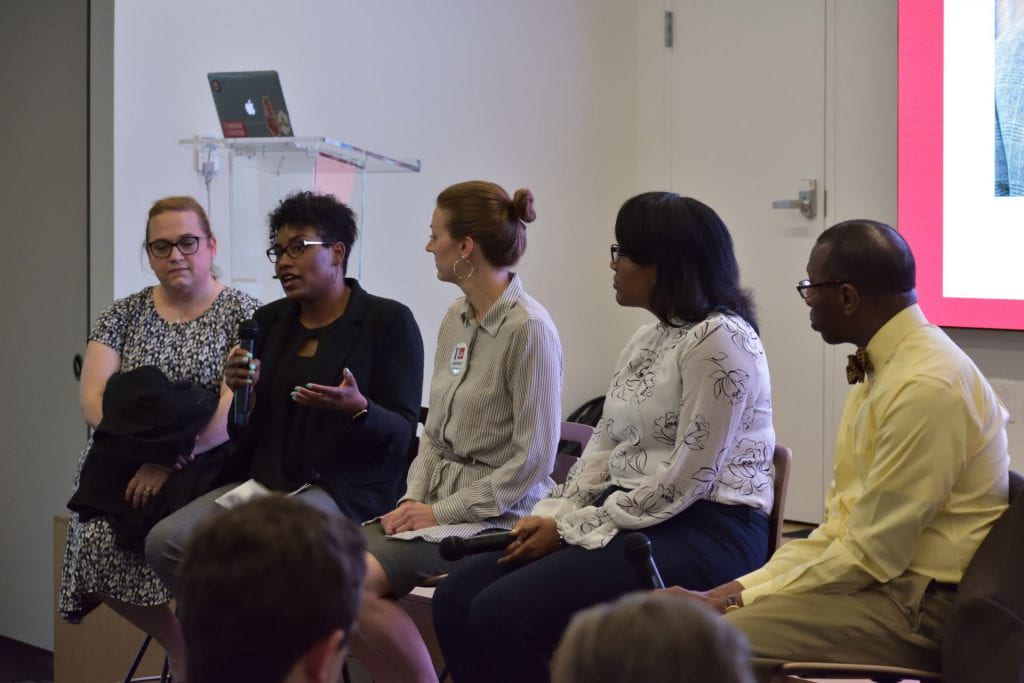There are many factors which can cause disparities in who has access to healthcare and the quality of the care they receive. To learn more about the specific issues facing St. Louis and how they are being addressed we invited Angela Brown, acting CEO of the St. Louis Regional Health Commission, Dr. Bettina Drake, Associate Director of Community Outreach and Engagement at the Siteman Cancer Center, Jessica Holmes, Principal Strategist for Alignment, Innovation, and Growth for the St. Louis Integrated Health Network, Dr. Will Ross, Associate Dean of Diversity at the Washington University School of Medicine in St. Louis, and Dr. Spring Schmidt, the current Acting Director of the St. Louis County Public Health Department to have a conversation about health disparities in our region on Thursday, May 23 at Innovation Hall in the Cortex.
We learned that the health disparities problems facing St. Louis are not unique to our city, but they are intensified by two primary factors: division between the City and County and extreme racial segregation. Having two separate governments operating in the same municipal area means that multiple initiatives may be formed to tackle the same problems, but never communicate or share resources. While some services, such as the sewer district and certain medical centers are shared, many more function independently, leaving independent organizations having to communicate and comply with two sets of legislatures and regulations.
St. Louis City has been ranked as the 10th most segregated city in the United states while the metropolitan area is the 6th most segregated. One poignant example of this is the Delmar Divide. Crossing from north of Delmar Boulevard to the south the population goes from over 98% African American to over 70% White, the median income increases by $30,000, the number of residents with bachelor’s degrees by 60%, and the median home value by $250,000. This is not the only location in St. Louis where such a start contrast can be seen, and this socioeconomic disparity has significant impacts on the health of residents.

This segregation can be reflected in cancer rate differences and outcomes in north St. Louis. Eight ZIP codes around Coldwater Creek were found to have higher rates of breast cancer and leukemia. These rates were highest among African American women. Furthermore, African American women were more likely to be diagnosed with later stages of breast cancer and have a mortality rate 10% higher than the total population. These women were more likely to delay diagnosis and treatment due to cost, both of which resulted in more late-stage diagnosis with worse outcomes. To address this and other issues, the Missouri Department of Social Services funded Gateway to Better Health in partnership with the St. Louis Regional Health Commission.
Gateway to Better Health was a pilot program to “provide uninsured adults a bridge in care until they are able to enroll in health insurance coverage options available through the Affordable Care Act.” The program was implemented in 2012 and set to expire in 2017, however it has been renewed and serves as a means of providing healthcare access to over 60,000 residents. Although the program helps many in the St. Louis area, the panelists agreed that it is a stop-gap measure incapable of adequately addressing the needs of the region.

These needs may grow in the near future due to funding cuts to the Medicaid Disproportionate Share Hospital Program (DSH). This program provides funds to hospitals that provide care to a disproportionately large number of uninsured and Medicaid insured individuals to offset the corresponding costs. DSH is federally funded and expected to be cut by $4 billion this year and an additional $8 billion over the next five years, justified in part by the Medicaid expansion in the Affordable Care Act. Missouri hospitals were expecting to lose over $157 million in funding last year alone which could have a devastating impact on the amount of services they are able to provide to low-income and un- or underinsured individuals. As Missouri is one of 13 states that has not accepted the Medicaid expansion, it will be disproportionately affected by these budget cuts.
While there are many challenges to fixing health care disparities in the St. Louis region there is some progress being made. The St. Louis Integrated Health Commission is working to bring together resources in the County, City, and from private organizations and reduce some of the inefficiencies and missed populations caused by lack of communication. There has been an increase in the use of community health workers, community members who often do not have medical training but are a key resource in helping people navigate the healthcare system, especially for the specific needs of at-risk populations. More research is also being done to address racial disparities in healthcare access and outcomes. There is still a long way to go and many problems to resolve, but we can all do our part to support the organizations directly working on these issues and by contacting our legislatures about fixing some of the systemic issues that drive health disparities. Having public conversations about the issues and hurdles we face is one step toward addressing disparities within the system and supporting the initiatives and healthcare workers who are working to diminish health disparities.
